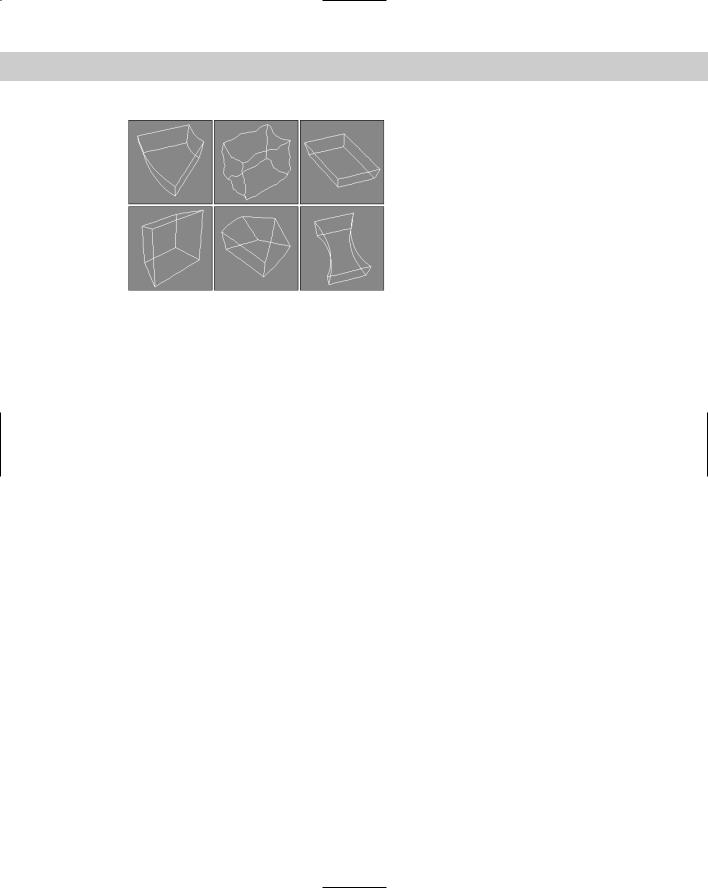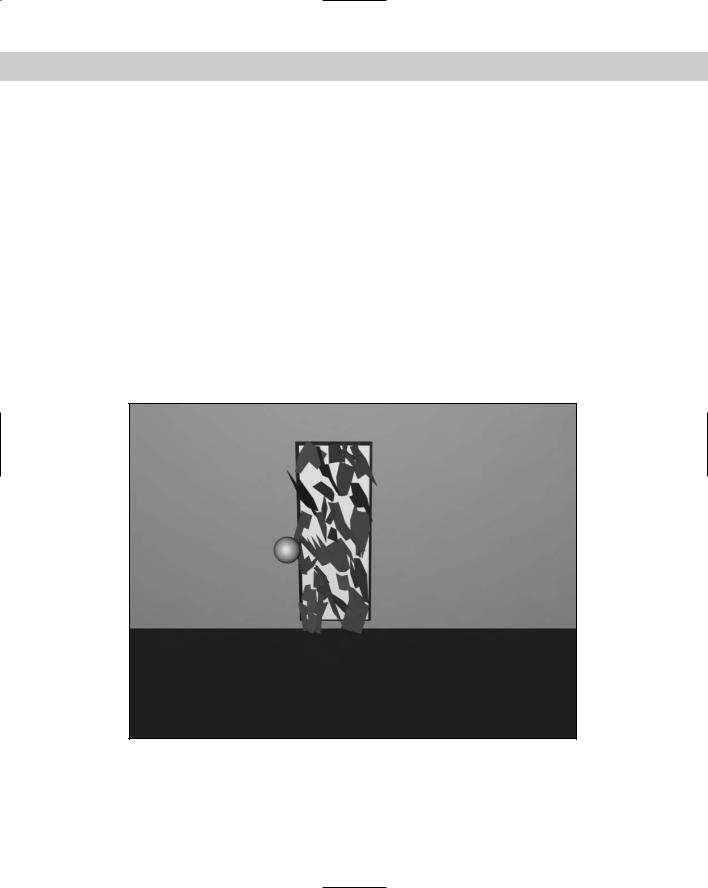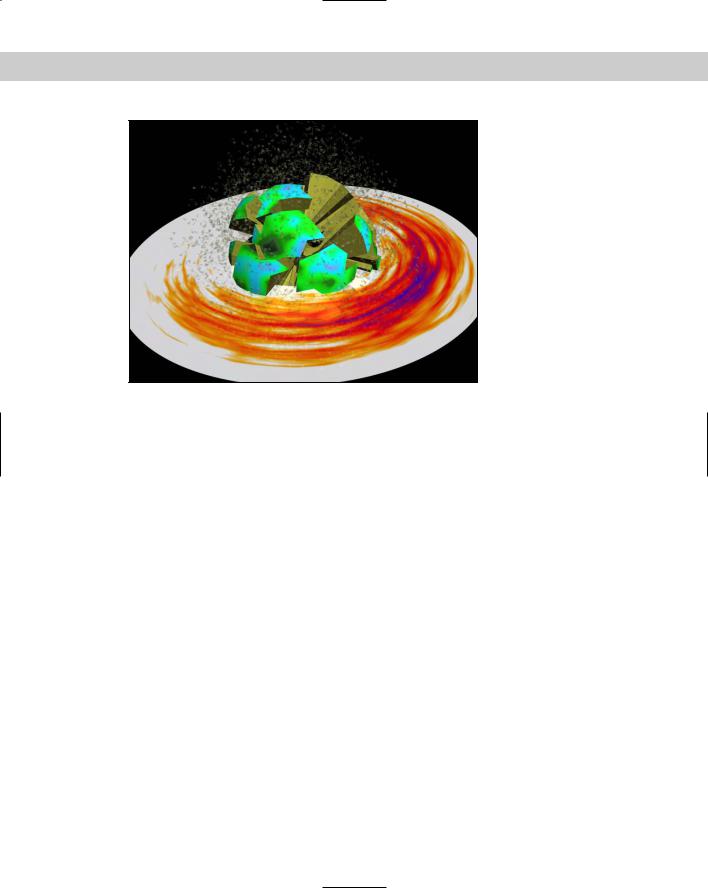
- •Preface
- •About This Book
- •Acknowledgments
- •Contents at a Glance
- •Contents
- •Relaxing at the Beach
- •Dressing the Scene
- •Animating Motion
- •Rendering the Final Animation
- •Summary
- •The Interface Elements
- •Using the Menus
- •Using the Toolbars
- •Using the Viewports
- •Using the Command Panel
- •Using the Lower Interface Bar Controls
- •Interacting with the Interface
- •Getting Help
- •Summary
- •Understanding 3D Space
- •Using the Viewport Navigation Controls
- •Configuring the Viewports
- •Working with Viewport Backgrounds
- •Summary
- •Working with Max Scene Files
- •Setting File Preferences
- •Importing and Exporting
- •Referencing External Objects
- •Using the File Utilities
- •Accessing File Information
- •Summary
- •Customizing Modify and Utility Panel Buttons
- •Working with Custom Interfaces
- •Configuring Paths
- •Selecting System Units
- •Setting Preferences
- •Summary
- •Creating Primitive Objects
- •Exploring the Primitive Object Types
- •Summary
- •Selecting Objects
- •Setting Object Properties
- •Hiding and Freezing Objects
- •Using Layers
- •Summary
- •Cloning Objects
- •Understanding Cloning Options
- •Mirroring Objects
- •Cloning over Time
- •Spacing Cloned Objects
- •Creating Arrays of Objects
- •Summary
- •Working with Groups
- •Building Assemblies
- •Building Links between Objects
- •Displaying Links and Hierarchies
- •Working with Linked Objects
- •Summary
- •Using the Schematic View Window
- •Working with Hierarchies
- •Setting Schematic View Preferences
- •Using List Views
- •Summary
- •Working with the Transformation Tools
- •Using Pivot Points
- •Using the Align Commands
- •Using Grids
- •Using Snap Options
- •Summary
- •Exploring the Modifier Stack
- •Exploring Modifier Types
- •Summary
- •Exploring the Modeling Types
- •Working with Subobjects
- •Modeling Helpers
- •Summary
- •Drawing in 2D
- •Editing Splines
- •Using Spline Modifiers
- •Summary
- •Creating Editable Mesh and Poly Objects
- •Editing Mesh Objects
- •Editing Poly Objects
- •Using Mesh Editing Modifiers
- •Summary
- •Introducing Patch Grids
- •Editing Patches
- •Using Modifiers on Patch Objects
- •Summary
- •Creating NURBS Curves and Surfaces
- •Editing NURBS
- •Working with NURBS
- •Summary
- •Morphing Objects
- •Creating Conform Objects
- •Creating a ShapeMerge Object
- •Creating a Terrain Object
- •Using the Mesher Object
- •Working with BlobMesh Objects
- •Creating a Scatter Object
- •Creating Connect Objects
- •Modeling with Boolean Objects
- •Creating a Loft Object
- •Summary
- •Understanding the Various Particle Systems
- •Creating a Particle System
- •Using the Spray and Snow Particle Systems
- •Using the Super Spray Particle System
- •Using the Blizzard Particle System
- •Using the PArray Particle System
- •Using the PCloud Particle System
- •Using Particle System Maps
- •Controlling Particles with Particle Flow
- •Summary
- •Understanding Material Properties
- •Working with the Material Editor
- •Using the Material/Map Browser
- •Using the Material/Map Navigator
- •Summary
- •Using the Standard Material
- •Using Shading Types
- •Accessing Other Parameters
- •Using External Tools
- •Summary
- •Using Compound Materials
- •Using Raytrace Materials
- •Using the Matte/Shadow Material
- •Using the DirectX 9 Shader
- •Applying Multiple Materials
- •Material Modifiers
- •Summary
- •Understanding Maps
- •Understanding Material Map Types
- •Using the Maps Rollout
- •Using the Map Path Utility
- •Using Map Instances
- •Summary
- •Mapping Modifiers
- •Using the Unwrap UVW modifier
- •Summary
- •Working with Cameras
- •Setting Camera Parameters
- •Summary
- •Using the Camera Tracker Utility
- •Summary
- •Using Multi-Pass Cameras
- •Creating Multi-Pass Camera Effects
- •Summary
- •Understanding the Basics of Lighting
- •Getting to Know the Light Types
- •Creating and Positioning Light Objects
- •Viewing a Scene from a Light
- •Altering Light Parameters
- •Working with Photometric Lights
- •Using the Sunlight and Daylight Systems
- •Using Volume Lights
- •Summary
- •Selecting Advanced Lighting
- •Using Local Advanced Lighting Settings
- •Tutorial: Excluding objects from light tracing
- •Summary
- •Understanding Radiosity
- •Using Local and Global Advanced Lighting Settings
- •Working with Advanced Lighting Materials
- •Using Lighting Analysis
- •Summary
- •Using the Time Controls
- •Working with Keys
- •Using the Track Bar
- •Viewing and Editing Key Values
- •Using the Motion Panel
- •Using Ghosting
- •Animating Objects
- •Working with Previews
- •Wiring Parameters
- •Animation Modifiers
- •Summary
- •Understanding Controller Types
- •Assigning Controllers
- •Setting Default Controllers
- •Examining the Various Controllers
- •Summary
- •Working with Expressions in Spinners
- •Understanding the Expression Controller Interface
- •Understanding Expression Elements
- •Using Expression Controllers
- •Summary
- •Learning the Track View Interface
- •Working with Keys
- •Editing Time
- •Editing Curves
- •Filtering Tracks
- •Working with Controllers
- •Synchronizing to a Sound Track
- •Summary
- •Understanding Your Character
- •Building Bodies
- •Summary
- •Building a Bones System
- •Using the Bone Tools
- •Using the Skin Modifier
- •Summary
- •Creating Characters
- •Working with Characters
- •Using Character Animation Techniques
- •Summary
- •Forward versus Inverse Kinematics
- •Creating an Inverse Kinematics System
- •Using the Various Inverse Kinematics Methods
- •Summary
- •Creating and Binding Space Warps
- •Understanding Space Warp Types
- •Combining Particle Systems with Space Warps
- •Summary
- •Understanding Dynamics
- •Using Dynamic Objects
- •Defining Dynamic Material Properties
- •Using Dynamic Space Warps
- •Using the Dynamics Utility
- •Using the Flex Modifier
- •Summary
- •Using reactor
- •Using reactor Collections
- •Creating reactor Objects
- •Calculating and Previewing a Simulation
- •Constraining Objects
- •reactor Troubleshooting
- •Summary
- •Understanding the Max Renderers
- •Previewing with ActiveShade
- •Render Parameters
- •Rendering Preferences
- •Creating VUE Files
- •Using the Rendered Frame Window
- •Using the RAM Player
- •Reviewing the Render Types
- •Using Command-Line Rendering
- •Creating Panoramic Images
- •Getting Printer Help
- •Creating an Environment
- •Summary
- •Creating Atmospheric Effects
- •Using the Fire Effect
- •Using the Fog Effect
- •Summary
- •Using Render Elements
- •Adding Render Effects
- •Creating Lens Effects
- •Using Other Render Effects
- •Summary
- •Using Raytrace Materials
- •Using a Raytrace Map
- •Enabling mental ray
- •Summary
- •Understanding Network Rendering
- •Network Requirements
- •Setting up a Network Rendering System
- •Starting the Network Rendering System
- •Configuring the Network Manager and Servers
- •Logging Errors
- •Using the Monitor
- •Setting up Batch Rendering
- •Summary
- •Compositing with Photoshop
- •Video Editing with Premiere
- •Video Compositing with After Effects
- •Introducing Combustion
- •Using Other Compositing Solutions
- •Summary
- •Completing Post-Production with the Video Post Interface
- •Working with Sequences
- •Adding and Editing Events
- •Working with Ranges
- •Working with Lens Effects Filters
- •Summary
- •What Is MAXScript?
- •MAXScript Tools
- •Setting MAXScript Preferences
- •Types of Scripts
- •Writing Your Own MAXScripts
- •Learning the Visual MAXScript Editor Interface
- •Laying Out a Rollout
- •Summary
- •Working with Plug-Ins
- •Locating Plug-Ins
- •Summary
- •Low-Res Modeling
- •Using Channels
- •Using Vertex Colors
- •Rendering to a Texture
- •Summary
- •Max and Architecture
- •Using AEC Objects
- •Using Architectural materials
- •Summary
- •Tutorial: Creating Icy Geometry with BlobMesh
- •Tutorial: Using Caustic Photons to Create a Disco Ball
- •Summary
- •mental ray Rendering System
- •Particle Flow
- •reactor 2.0
- •Schematic View
- •BlobMesh
- •Spline and Patch Features
- •Import and Export
- •Shell Modifier
- •Vertex Paint and Channel Info
- •Architectural Primitives and Materials
- •Minor Improvements
- •Choosing an Operating System
- •Hardware Requirements
- •Installing 3ds max 6
- •Authorizing the Software
- •Setting the Display Driver
- •Updating Max
- •Moving Max to Another Computer
- •Using Keyboard Shortcuts
- •Using the Hotkey Map
- •Main Interface Shortcuts
- •Dialog Box Shortcuts
- •Miscellaneous Shortcuts
- •System Requirements
- •Using the CDs with Windows
- •What’s on the CDs
- •Troubleshooting
- •Index

934 Part IX Dynamics
Figure 38-19: The Modifier-Based Space Warps:
Bend, Noise, Skew, Taper, Twist, and Stretch
Combining Particle Systems with Space Warps
To conclude this chapter, let’s look at some examples that use Space Warps along with particle systems. With all these Space Warps and their various parameters combined with particle systems, the possibilities are endless. These examples are only a small representation of what is possible.
Tutorial: Shattering glass
When glass shatters, it is very chaotic, sending pieces in every direction. For this tutorial, we shatter a glass mirror on a wall. The wall keeps the pieces from flying off, and most pieces fall straight to the floor.
To shatter glass, follow these steps:
1.Open the Shattering glass.max file from the Chap 38 directory on the CD-ROM.
This file includes a simple mirror created from patch grid objects. The file also includes a simple sphere that is animated striking the mirror.
2.Select the Create Particles PArray menu command. Then drag in the Front viewport to create the PArray icon. In the Basic Parameters rollout, click the Pick Object button and select the first patch object. In the Viewport Display section, select the Mesh option. In the Particle Generation rollout, set the Speed and Divergence to 0. Also set the Emit Start to 30 and the Life value to 100, so it matches the last frame. In the Particle Type rollout, select the Object Fragments option, and set the Thickness to 1.0. Then in the Object Fragment Controls section, select the Number of Chunks option with a Minimum value of 30. In the Rotation and Collision rollout, set the Spin Time to 100 and the Variation to 50.
These settings cause the patch to emit 30 object fragments with a slow, gradual rotation.

Chapter 38 Using Space Warps 935
3.Select the Space Warps category button, and choose the Forces subcategory from the drop-down list. Click the PBomb button, and create a PBomb Space Warp in the Top view, then center it above the Mirror patch. In the Modify panel, set the Blast Symmetry option to Spherical with a Chaos value of 50 percent. Set the Start Time to 30 with a Strength value of 0.2. Then click the Bind to Space Warp button, and drag from the PBomb Space Warp to the PArray icon.
4.Select the Create Space Warps Forces Gravity menu command, and drag in the Front viewport to create a Gravity Space Warp. Position the Gravity Space Warp so that the icon arrow is pointing down in the Front viewport. In the Modify panel, set the Strength value to 0.1. Then bind this Space Warp to the PArray icon.
5.Select the Create Space Warps Deflectors PDynaFlect menu command. Drag this Space Warp in the Top view, and make it wide enough to be completely under the mirror object. Rotate the PDynaFlect Space Warp so that a single large arrow is pointing up at the mirror. Position it so that it lies in the same plane as the plane object that makes up the floor. In the Modify panel, set the Reflects value to 100 percent and the Bounce value to 0. Bind this Space Warp to the PArray as well; this keeps the pieces from falling through the floor.
Figure 38-20 shows the mirror immediately after being struck by a ball.
Figure 38-20: A shattering mirror

936 Part IX Dynamics
Tutorial: Exploding a planet
Combining a PBomb with a PArray and a Ringwave object for a shockwave can create an attention-getting explosion. The file actually includes two Geospheres, one for the planet and the other to be used for an exploding layer of dust.
To explode a planet, follow these steps:
1.Open the Exploding Planet.max file from the Chap 38 directory on the CD-ROM. This file includes a couple of Geosphere objects and a Ringwave object.
2.Select Particle Systems from the subcategory drop-down list, and click the PArray button. Create a PArray object in the Front viewport. Then click the Pick Object button, and select the first Geosphere. In the Viewport Display section, select the Mesh particles option. In the Particle Generation rollout, set the Speed to 10 and the Variation to 100. Then set the Emit Start to 30 and the Display Until and Life values to 100. In the Particle Type rollout, select Object Fragments, and set the Thickness to 100 and the number of Chunks to 20. In the Material Mapping and Source section, select the Picked Emitter option, and set values of 1, 2, and 3 for the Outside ID, the Edge ID, and the Backside ID. In the Rotation and Collision rollout, set the Spin Time to 50 with a Variation of 100.
3.Drag again in the Front viewport to create a second PArray. Under the Basic Parameters rollout, click the Pick Object button and select the second Geosphere. In the Particle Generation rollout, set the Speed to 10 and the Variation to 100. Then set the Emit Start value to 25 and the Life value to 30. In the Particle Type rollout, select Object Fragments, set the Thickness to 1, and select the All Faces option. In the Material Mapping and Source section, select the Icon option. In the Rotation and Collision rollout, set the Spin Time to 20.
This PArray is used to create the initial dust cloud.
4.Select the Space Warps category button, and choose Forces from the subcategory drop-down list. Click the PBomb button, and create two PBomb objects; then click the Bind to Space Warp button on the main toolbar, and drag from the first PBomb to the first PArray and from the second PBomb to the second PArray. Open the Modify panel, and select each PBomb in turn, setting the Start Time for the first PBomb to 30 and the second to 25. Position both PBomb icons so they are within the Geospheres.
Tip |
Make the two PBomb icons different sizes so they are easier to select. |
Figure 38-21 shows the resulting planet as the explosion first starts.

Chapter 38 Using Space Warps 937
Figure 38-21: Exploding a planet with a PBomb and a Ringwave
Tutorial: Making water flow down a trough
That should be enough destruction for a while. In this final example, we’ll make some water particles flow down a trough. This is accomplished using the Path Follow Space Warp.
To make water flow down a trough, follow these steps:
1.Open the Water flowing down a trough.max file from the Chap 38 directory on the CD-ROM.
This file includes a simple trough made from primitives and a spline path that the water will follow.
2.Select Particle Systems from the subcategory drop-down list, and click the Super Spray button. Create a Super Spray object in the Front viewport. In the Viewport Display section, select the Ticks particles option. In the Particle Generation rollout, set the Speed to 10 and the Variation to 100. Then set the Emit Start to 0 and the Display Until and Life values to 100. In the Particle Type rollout, select MetaParticles and enable the Automatic Coarseness option.
3.Select the Space Warps category button, and choose Forces from the subcategory drop-down list. Click the Path Follow button, and create a Path Follow objects; then click the Bind to Space Warp button on the main toolbar, and drag from the Path Follow icon to the first Super Spray icon. Open the Modify panel, select the Path Follow icon, click the Pick Shape Object button, and select the path in the viewports. Set the Start Frame to 0 and the Travel Time to 100.
Figure 38-22 shows the rendered result.
